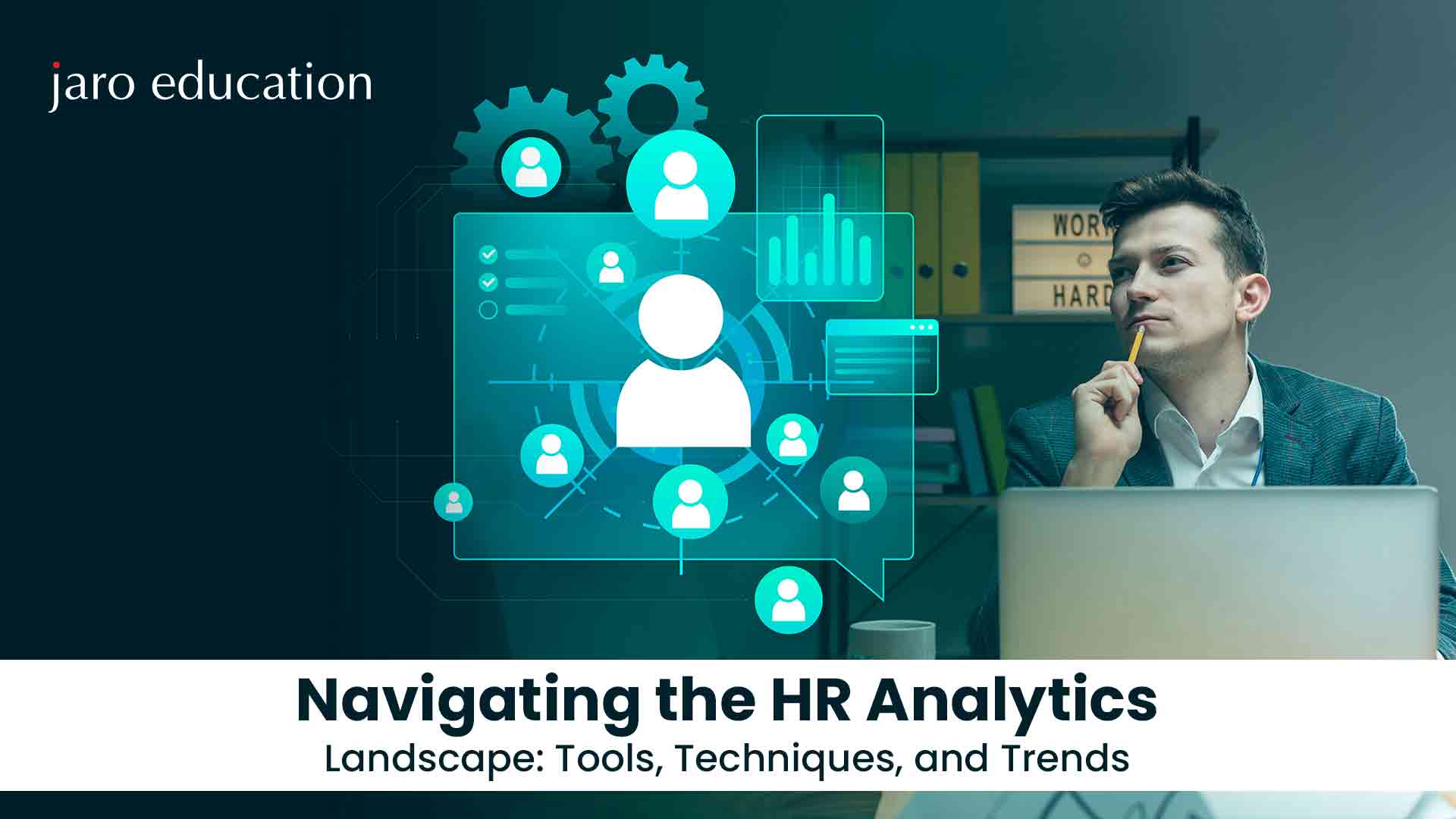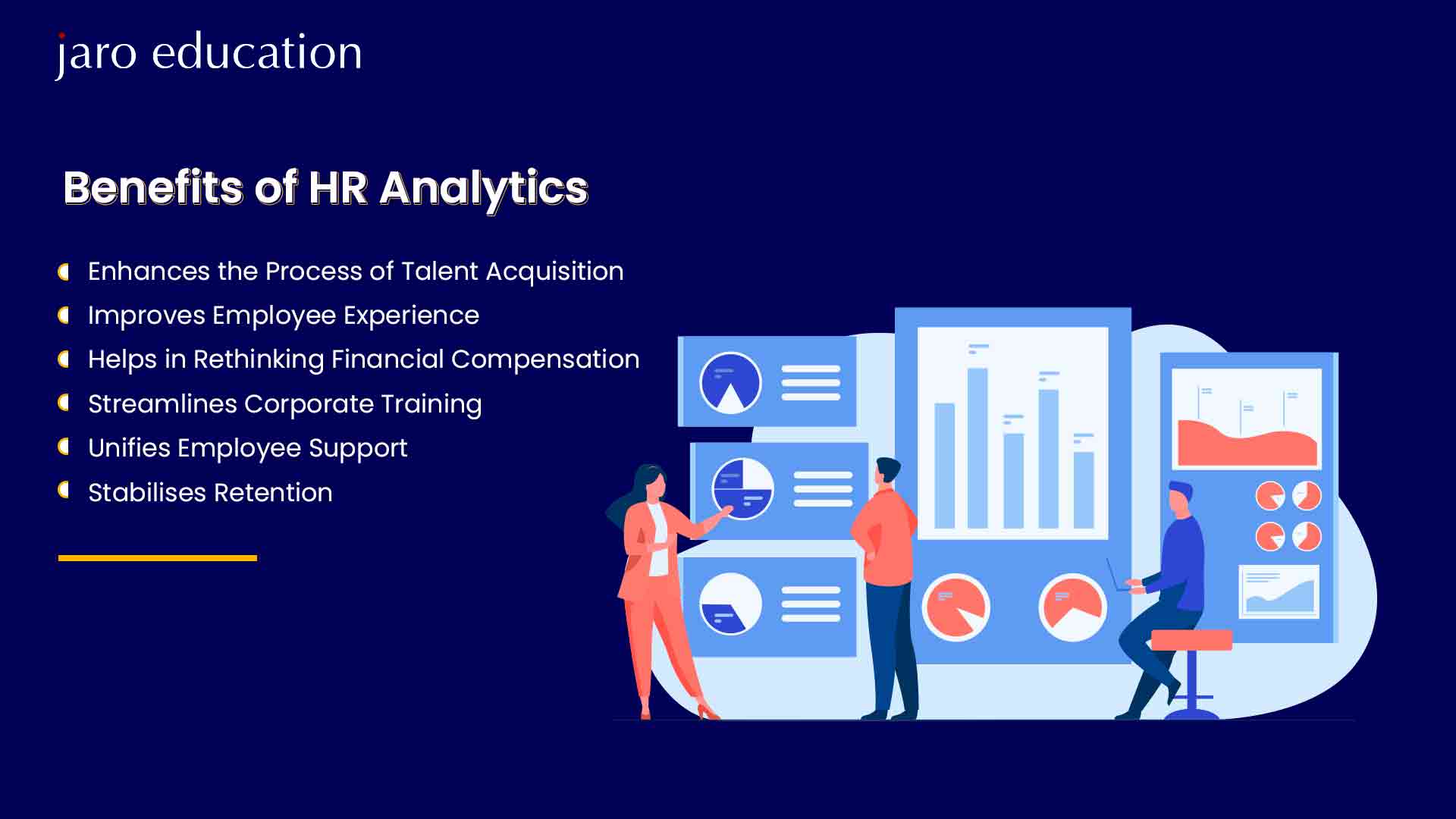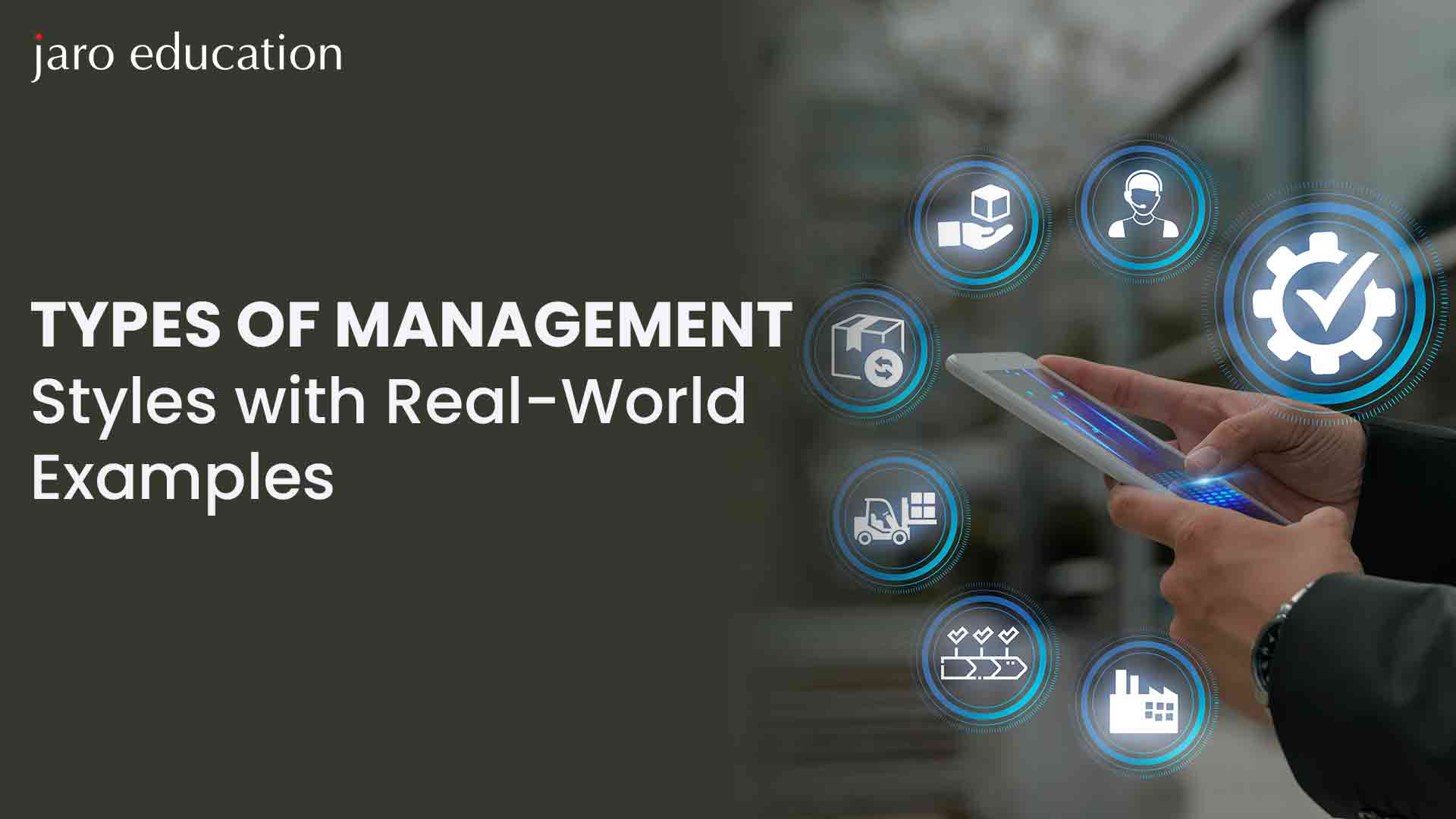
- jaro education
- 16, April 2024
- 10:00 am
In today’s fast-changing business world, Human Resource Management (HRM) is going through a big change because of using data more smartly. Instead of just relying on feelings or guesses, companies are now using numbers and facts to make HR decisions.
HR analytics is a big part of this change. It helps HR departments look deeply into data, find patterns, and make smart choices to boost productivity and improve performance. Even though HR faces many challenges like hiring the right people, keeping employees, training them well, managing pay, and planning careers, using data can help solve these problems better.
One key thing HR analytics shows is how important it is to have the right information at the right time, especially when it comes to recognizing and rewarding employees. If companies don’t recognize and reward good work, employees can feel unhappy and may even leave. That’s why many organizations are using HR analytics to create fair incentives, pay structures, and promotion rules based on how well employees actually perform. This article will help you to get a good grasp on the HR analytics landscape, tools, techniques and trends.
Table of Contents
Understanding HR analytics
HR analytics, also known as people analytics or workforce analytics, entails the collection, analysis, and presentation of HR data. This practice empowers organizations to gain deeper insights into their workforce, assess the influence of various HR metrics on overall business success, and make informed decisions based on data. Essentially, HR analytics represents a data-centric approach to managing Human Resources.
While the term “HR analytics” is commonly used, there’s a growing inclination towards the term “people analytics” as well. While these terms are often used interchangeably, there exists a nuanced disparity. HR analytics primarily draws upon data housed within HR departments and aims at enhancing HR functions. On the other hand, people analytics encompasses a broader spectrum by integrating data from diverse sources within the organization, including marketing, finance, and customer statistics, to tackle a wider array of business challenges.
Over the past century, Human Resource Management has undergone a significant transformation from being primarily operational to adopting a more strategic role. This transition is exemplified by the rising popularity of the term Strategic Human Resource Management. The data-driven methodology inherent in HR analytics aligns seamlessly with this evolution.
By leveraging analytics, HR professionals can base their decisions on empirical evidence rather than solely relying on intuition and subjective viewpoints. Moreover, analytics serves as a means to evaluate the efficacy of HR policies and interventions, contributing to informed decision-making and continuous improvement.
Categories of HR Analytics
Various data analysis methodologies offer insights and uncover patterns within datasets. Familiarity with these methodologies aids in comprehending how analytics can enhance HR planning and decision-making processes.
Outlined below is a concise overview of the four categories of HR analytics:
- Descriptive HR Analytics: Analyzes historical data to understand past occurrences within a specified timeframe. (For instance, analyzing the annual employee turnover rate.)
- Diagnostic HR Analytics: Investigates data to determine the root causes of past events and behaviors. (For example, examining unplanned absence data to pinpoint the factors driving absenteeism.)
- Predictive HR Analytics: Examines both current and historical data, utilizing statistical models and forecasts to anticipate future behaviors and occurrences. (As an illustration, analyzing recruitment data to identify the essential attributes of an ideal candidate for a specific role.)
- Prescriptive HR Analytics: Proposes potential future outcomes and scenarios, along with recommendations for addressing them. (For instance, developing an algorithm that predicts the onboarding needs of a new hire based on their experience and skill set.)
Importance of HR Analytics
The significance of HR analytics lies in its capacity to elevate HR’s role within companies, transitioning it from a mere operational unit to a strategic partner. Utilizing data allows HR to understand the repercussions of its policies, thereby aligning its strategies with overarching business objectives and quantifying its contributions.
Leveraging HR analytics helps HR to:
- Enhance decision-making processes, leveraging insights provided by data to better serve both employees and the organization.
- Identify and rectify inefficiencies, thereby enhancing productivity and reducing costs at both individual and organizational levels.
- Develop compelling arguments for HR interventions by substantiating them with data-driven evidence.
- Evaluate the effectiveness of HR initiatives and policies, ensuring they meet their intended goals.
- Assess and fortify efforts related to Diversity, Equity, Inclusion, and Belonging (DEIB).
- Take proactive measures to navigate through periods of change, disruption, and uncertainty.
After understanding the basics of HR analytics and its importance let’s jump into some prominent HR analytics tools to optimize an organization’s workspace.

Professionals looking to excel in HR analytics roles must have a comprehensive understanding of HR processes, statistical techniques, data visualization, and data analysis methodologies. Career opportunities in HR analytics span across various sectors, including large enterprises, consulting firms, HR technology companies, and startups, offering a diverse range of prospects for those interested in this field.
Moreover, the timing couldn’t be better to pursue a career in HR analytics. Many leading business schools now integrate HR analytics courses into their professional degree programs, such as Executive Development Program in HR Analytics by XLRI Jamshedpur providing aspiring professionals with the necessary skills and knowledge to thrive in this evolving landscape. As organizations continue to leverage data-driven insights to enhance their HR strategies, the role of HR analytics specialists will only become more pivotal in shaping the future of human resource management.
HR Analytics Tools
1. ChartHop
ChartHop is a specialized software solution for people analytics aimed at facilitating comprehensive planning and fostering cross-team communication within organizations. It was meticulously crafted to provide easy access to various analytics tailored for common HR challenges and inquiries. Its functionalities encompass modules for headcount planning, performance evaluation, compensation management, and enhancing employee experience.
Key feature: Seamless integration capabilities and an extensive repository of pre-designed analytics templates to expedite implementation.
Reasons to consider ChartHop: It offers a valuable option for companies seeking to democratize access to people analytics across their workforce and streamline HR analytics workflows.
2. IBM ILOG CPLEX
IBM ILOG CPLEX Optimizer is a sophisticated tool designed for tackling intricate optimization problems. Originating in 1987, ILOG initially focused on analytics visualization tools and later expanded its offerings by acquiring CPLEX Optimizer in 1993, amalgamating them into a comprehensive suite for optimizing business processes. Following IBM’s acquisition of ILOG in 2009, the core tools underwent continuous enhancement, resulting in improvements such as a more user-friendly interface, enhanced data integration, and support for contemporary cloud architectures. While technically demanding, it serves as a valuable asset for HR departments dealing with complex scheduling decisions and workforce optimization strategies for new markets and corporate expansions.
Key feature: A robust toolkit for articulating complex optimization challenges.
Reasons to consider ILOG CPLEX Optimizer: It proves advantageous when the HR team faces significant workforce transitions, such as establishing new facilities, expanding into new markets, or launching major products.
3. Microsoft Excel
Microsoft Excel stands out as the leading software in the industry for extracting and conveying analytical insights throughout organizations. Its widespread usage among business users enhances its appeal, as it offers a familiar interface. This makes it an ideal tool for translating intricate data into easily comprehensible formats, particularly beneficial for finance and planning departments. Additionally, Excel facilitates data manipulation and analysis across various departments within a company. Microsoft consistently enhances Excel by introducing programming tools to streamline data capture, report generation, and sharing processes among teams. Moreover, there exists a plethora of third-party HR analytics templates compatible with Excel.
Key attributes: Widely recognized and utilized across business and finance sectors.
Reasons to consider Excel: Its ubiquity in the corporate world simplifies communication across HR, business, finance, and marketing teams, making it an appealing option for integrating existing HR analytics workflows.
4. Microsoft Power BI
Microsoft Power BI emerges as the dominant player in the business intelligence tools market, boasting comprehensive integrations with major HR applications and platforms. Offering diverse methods for data analysis, presentation, and visualization, Power BI seamlessly complements Excel, further enhancing communication within organizations. Furthermore, it is bolstered by various third-party HR dashboard solutions, analytics tools, and consulting services.
Key attributes: Preeminent platform for creating analytics dashboards and metrics.
Reasons to consider Power BI: Ideal for companies seeking to tailor their HR analytics or collaborate with consultancies specializing in this platform.
5. Visier
Visier, on the other hand, concentrates squarely on HR analytics. The platform is tailored to seamlessly integrate HR insights into existing HR workflows, rather than merely offering statistical data. For instance, it features modules designed to assist HR teams in resolving workforce planning, attrition, diversity, and inclusion issues. Moreover, it provides tools for managing the recruitment pipeline, retaining high-performing employees, and evaluating the effectiveness of training programs.
Key characteristics: Facilitates effortless integration with popular HR tools and platforms and boasts a wide array of commonly used HR analytics templates.
Reasons to consider Visier: It presents a viable option for teams aiming to swiftly transition HR analytics into production with minimal technical proficiency.
Best Techniques to Implement HR Analytics
Implementing an HR analytics strategy varies depending on the circumstances. The crucial aspect is striking a balance between cost-effective metrics and tools that offer valuable insights into the human resources aspect of your company. While insufficient data can harm your business, excessive investment in analytics relative to your business size can also lead to inefficiencies. Here are some recommended approaches:
- Promote data-driven decision-making: Encourage managers to base their decisions on data obtained through people analytics. Integrating data measurement into hiring processes and employee performance evaluations compels the entire team to utilize data and derive recommendations from it.
- Optimize tool selection: Instead of acquiring every available tool, focus on selecting those that provide the most relevant insights into employee performance and satisfaction. The ideal tool mix depends on your specific measurement needs and frequency. Some tools can also streamline business management tasks like employee reviews.
- Pose data-driven queries: During managerial meetings, ask questions that necessitate an understanding of relevant metrics. For instance, inquire about the time taken to fill recent job vacancies, requiring managers to engage with relevant data.
- Act on insights: Rather than merely collecting and reporting data, leverage it to drive action. When data suggests a course of action aligned with business objectives, implement it to maximize returns on investment.
- Secure leadership support: For HR analytics to be effective, it must have buy-in from the leadership team. Ensuring their commitment and ongoing prioritization of analytics within the organization is crucial for success.
- Receive feedback: Given that HR analytics relies heavily on human input, continuously gather feedback from employees to refine processes and maximize effectiveness.
Top HR Analytics Trends in 2024
AI-driven HR Analytics
A significant trend expected to shape HR analytics in 2024 is the heightened adoption of AI-powered analytic tools. These tools empower HR professionals to swiftly and accurately process extensive data sets, unveiling insights and patterns that might otherwise remain concealed. Additionally, AI-driven analytics facilitate more informed decision-making, enabling HR teams to pinpoint top candidates for positions and anticipate potential employee attrition.
Predictive Analytics
Another pivotal development in HR analytics for 2024 is the increased integration of predictive analytics. By leveraging predictive models, HR practitioners can discern patterns and trends indicative of future outcomes. For instance, predictive analytics can assist in identifying employees likely to leave the organization or determining which job applicants are best suited for specific roles.
Enhanced Focus on Employee Engagement
An emerging emphasis within HR analytics for the year ahead is a heightened focus on employee engagement. Through analytics tools, HR specialists can delve into the drivers of employee motivation, satisfaction, and engagement, facilitating a deeper understanding of factors influencing workforce dynamics and productivity. By prioritizing employee engagement, organizations stand to bolster retention rates, foster greater productivity, and ultimately enhance overall performance.
Amplified Utilization of Real-Time Data
As technology advances, the utilization of real-time data is poised to surge among HR professionals in 2024. Real-time data offers timely insights into employee performance, engagement levels, and other critical metrics, empowering HR teams to make prompt, well-informed decisions to address evolving organizational needs effectively.
Enhanced Data Visualization
In the realm of HR analytics for 2024, expect to witness strides in data visualization capabilities. Improved visualization tools enable HR practitioners to readily discern patterns and trends within data, facilitating clearer communication of insights across the organization. This enhancement in data visualization is anticipated to underpin more informed decision-making processes at all organizational levels.
Sentiment Analysis
An integral aspect of HR analytics in the coming year will be the application of sentiment analysis. By analyzing the emotional tone conveyed in written or verbal communication, HR teams can gauge employee sentiment toward the organization, their work, and colleagues. This insight equips organizations to preemptively address potential issues, nurturing a more positive and supportive workplace culture.
Employee Engagement
Amid the landscape of HR analytics in 2024, a focal point remains on measuring and improving employee engagement. Through data-driven assessments of engagement levels, HR teams can pinpoint areas requiring attention and implement targeted initiatives to enhance overall workforce engagement. This may entail initiatives such as promoting growth opportunities, fostering transparent communication, and cultivating a supportive organizational culture.
Integration of blockchain technology
Blockchain denotes a decentralized ledger technology that ensures secure and transparent data management. Within HR Analytics, blockchain can be harnessed to establish a secure and effective framework for managing employee data encompassing payroll particulars, performance archives, and benefits information.
Elevated emphasis on employee experience (EX) indicators
EX indicators embody a range of metrics targeting the holistic employee experience, spanning facets like job contentment, work-life equilibrium, and engagement levels. HR Analytics is progressively deployed to monitor and analyze EX indicators, furnishing organizations with actionable insights to enhance their HR protocols and foster a conducive workplace environment.
Assimilation of social media insights
Social media platforms are increasingly leveraged for recruitment endeavors and bolstering employer image. Through HR Analytics, social media data can be dissected to pinpoint prospective candidates, gauge brand sentiment, and quantify the efficacy of social media campaigns.
Conclusion
The rising recognition of the significance of data-driven decision-making in human resources is reshaping the way organizations operate. This paradigm shift has fueled a growing demand for HR analytics specialists who possess a strong foundation in both human resources and data analytics. To excel in this field, professionals need to be well-versed in HR procedures, statistical techniques, data visualization, and data analysis.









